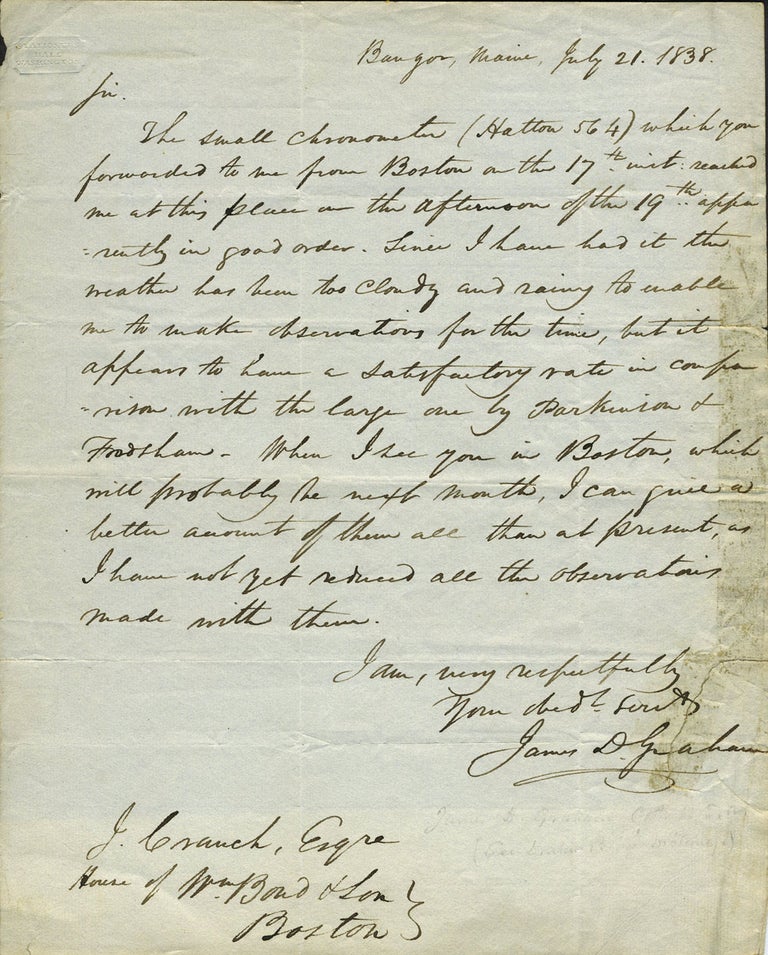ALS regarding a Chronometer Recently Acquired to survey boundaries of Maine & the New Republic of Texas, by this early member of the Army Corps of Topographical Engineers.
Bangor, Maine: 1838. Signed letter from Major James D. Graham, addressed to "House of Wm. Bond & Son, Boston", on letter with the blind stamp "Stationers Hall Washington", dated July 21, 1838, Bangor Maine, regarding chronometers he recently obtained.
Graham, an 1817 graduate of West Point, was a prominent topographical engineer. From 1819 to 1821 he served as Lt. and First Assistant on Stephen Long's western expedition from Pittsburgh to the Rocky Mountains, on which the topographer William Swift's map was based. The Swift map greatly influenced migration to the west, being one of the most widely available of the early maps of the westward route. He later served as astronomer of the newly created Corps of Topographical Engineers, on the surveys that established the boundary line between the United States & Canada as well as the boundary for the newly formed Republic of Texas (1839 - 1840). He was also the Principal Astronomer and "Head of the Scientific Corps," on the part of the United States, for the joint demarcation of the Boundary between the United States and Mexico, under the Treaty of Guadalupe Hidalgo, 1850-51. In 1858-59, he discovered the existence of a lunar tide.
In the letter Graham thanks J. Cranch of William Bond & Son of Boston for the chronometer, a "Hatton 564" and notes that the weather has been too cloudy recently for him to make observations with it. He anticipates giving a better account of the chronometer in comparison to the Parkinson & Frodsham (British firm) he already owns, the following month. The House of Representatives document no. 70, dated Feb. 1842 states that 452 transit observations were made "aided by three excellent chronometers, for the determination of the true meridian direction..." Graham refers to to multiple chronometers in his letter- "When I see you in Boston, which will probably be next month, I can give a better account of them all than at present, as I have not yet reduced all the observations made with them." The chronometers mentioned in this letter of 1838 were likely used in the surveying of both borders.
The firm of William Bond & Son was established in Boston in 1793 and became one of the best known American chronometer makers; the firm made the first seagoing chronometer during the War of 1812 when the market was dominated by British chronometer makers. Interestingly, the chronometer Graham refers to in the letter to Bond is a British made Hatton model, a firm which made marine chronometers for the East India Company.
The Republic existed from April 21, 1836 to February 19, 1846 and was formed by the defeat of Mexico in the Texas Revolution. A commission was established to survey the boundary between the two nations in 1838 but the survey was not completed until June 1841. The joint boundary commission included two U.S. Army surveyors- Major J. D. Graham & Lieutenant Thomas Lee, and a civilian civil engineer named G. G. Meade (who later commanded the Army of the Potomac at the battle of Gettysburg.) Its boundaries encompassed an area that included all of the present day state of Texas, as well as parts of present day New Mexico, Oklahoma, Kansas, Colorado, and Wyoming.
Traces of repairs on verso of right edge with old sticky tape; closed tear through last name only of signature. 8 x 10" Otherwise very good condition. Item #20853
Sold


